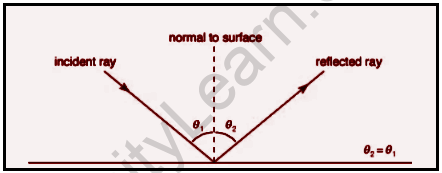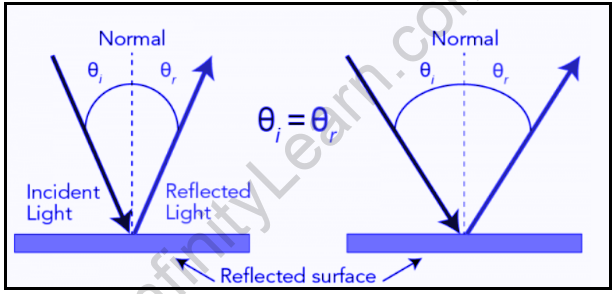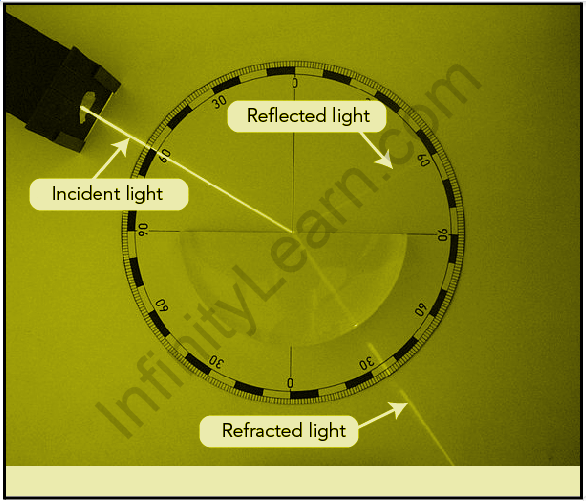Table of Contents
Introduction
When light rays reflect off a surface, move from one transparent medium to another, or travel through a medium whose composition is constantly changing, they change direction. The angle of the reflected ray is equal to the angle of the incident ray when reflected from a smooth surface, according to the law of reflection. (All angles are measured in geometrical optics with regard to the normal to the surface—that is, a line perpendicular to the surface).
The reflected ray always falls in the plane defined by the incident ray and the surface normal. To comprehend the images produced by plane and curved mirrors, the law of reflection can be applied. Because most natural surfaces, unlike mirrors, are rough on the scale of light wavelengths, parallel incident light rays are reflected in a range of directions or diffusely.
The ability to see most illuminated surfaces from any position is due to diffuse reflection—rays reach the eyes after reflecting off every portion of the surface. When light travelling through one transparent medium encounters a boundary with another transparent medium (e.g., air and glass), some of the light is reflected and some is transmitted into the second medium. As the transmitted light enters the second medium, its direction of travel changes; it is refracted.
Light is a vital component of life. Although the study of light dynamics can be perplexing at times, the refraction and reflection aspects of light are quite simple and have a wide range of applications. As demonstrated in the preceding discussion, refraction and reflection differ in a number of ways. However, there are some similarities between these two light phenomena. To begin with, they are applicable to all types of waves, including light waves. They also aid in the visibility of bodies in the universe because some bodies reflect light from the sun while others twinkle due to differences in the densities of layers of the atmosphere.
Overview
There is a distinct difference between reflection and refraction, and it is critical to analyze both terms and understand their definitions. Reflection is simply the property of light that bounces back after striking a surface. When light passes through a surface and undergoes some changes in appearance, as it does when it usually passes through a medium, this phenomenon is known as refraction.
The incident ray and the reflected ray are the two types of lights that are typically involved in this. Light energy is incredible and has numerous applications.
Reflection occurs when a wave encounters a boundary between two media with different wave speeds, but the wave remains in the original medium rather than passing into the second medium. The angle of incidence is equal to the angle of reflection.
Refraction is the change in the propagation direction of waves as they pass through a medium with a different speed. It occurs when waves strike the surface at an angle other than the normal to the surface. When moving to a medium where the waves slow down, the wave direction reverses (Snell’s Law).

Define reflection and refraction
Reflection of light occurs when a ray of light returns to the same medium after striking the surface of another medium. In other words, reflection is the bouncing back of light rays from the same medium’s surface. Reflection occurs when light passing through one material bounces off another. The reflected light continues to travel in a straight line, but in a different direction. The light is reflected at the same angle at which it strikes the surface. The incidence angle equals the reflection angle. The angle of incidence is the angle formed by the incoming light and a perpendicular to the surface line known as the normal. The angle of reflection is defined as the angle formed by the reflected light and the normal light. The symbol means “angle,” and the arrows represent light rays.

The refraction of light refers to the change in direction and speed of light as it passes through one medium and into another. Lenses, prisms, and telescopes are all examples of refraction. When light passing through one material reaches a second material, some of it is reflected and some of it enters the second material. The light will bend and travel in a different direction than the incident light when it enters the second material. This is known as refraction. Refraction occurs because the speed of light varies between materials (though always less than the speed of light in a vacuum).

Reflection and refraction examples
Examples of light refraction:
- The twinkling of stars in a clear night sky.
- The pool of water appears to be shallower than it is.
- A rainbow appears in the sky.
- camera lenses
- Eyeglasses
Examples of light reflection
- Reflection by a plane mirror.
- A spherical mirror’s reflection.
Reflection of light and refraction of light
Reflection of light occurs when a ray of light returns to the same medium after striking the surface of another medium.
The refraction of light refers to the change in direction and speed of light as it passes through one medium and into another.
Also read: Law of Reflection: Explanation and Statements
FAQs
Question 1: What exactly do you mean by the power of a lens?
Answer 1: The ability of a lens to converge or diverge light rays is referred to as its power.
Question 2: What kind of mirrors are used in vehicle headlights, and why?
Answer 2: Concave mirrors are used in headlights to create a parallel beam of light.





